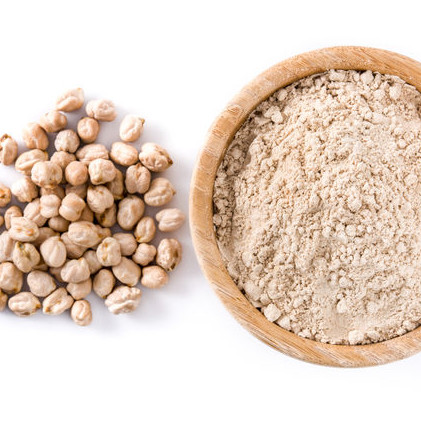
Garbanzo Bean Flour
Also known as chickpea flour
What is Garbanzo Bean Flour?
Garbanzo flour or chickpea flour is a gluten-free powder made from garbanzo bean milling. It is a white variety of chickpea bean (Cicer arietinum L.) that is high in protein, starch and dietary fiber.
Common uses of garbanzo flour include:1,2
- Nutritional fortification
- Functional improvement of wheat flour when used as a partial substitute in baking applications
Origin
The origin of garbanzo beans dates back 5000 years to Mesopotamia.1 Its cultivation started In the 16th century which then expanded to subtropical regions of the world with the Spanish and Portuguese explorations.1,2
Today, garbanzo bean is a staple food in India and the Middle Eastern cuisine, and is mainly produced mainly in the Middle East and India.1
Function
In baked goods, garbanzo bean flour serves several functions:1,2
- Provide structure: garbanzo bean starch contributes to the development of structure via interacting with the gluten in wheat flour.
- Liquid absorption: its high water absorption aids in binding ingredients.
- Flavor: provides a characteristic earthy, nutlike taste.
- Color: provides a characteristic pale yellow color. Its protein and sugar components can undergo Maillard browning reaction.
- Nutritional value: mainly due to its high protein content, dietary fiber and minerals.
Nutrition
Typical nutritional value of commercial garbanzo bean flour per 100 g:3
| Component | Grams |
| Carbohydrate | 60 |
| Protein | 20 |
| Water | 13.33 |
| Fat | 6.67 |
This flour provides 367 kcal per 100 g. It is also a good source of dietary fiber and minerals such as magnesium, iron, copper and zinc. Consumption of garbanzo beans may help reduce cholesterol and blood sugar level.1,2
Commercial production
Garbanzo bean flour is commercially manufactured through the following process:2
- Soaking: garbanzo beans are soaked in water to remove unwanted components
- Drying: at 100°C (212°F)
- Milling: grinding using roller mills to reduce particle size into a fine powder
- Grading: using various sieves
- Packaging: in plastic bags to be stored in cool, dry environments
Application
Garbanzo bean flour is used as a partial substitute for wheat flour, to reduce gluten content and as a nutraceutical ingredient due to its high plant-based protein content. It is typically mixed with dry ingredients such as wheat flour. Garbanzo bean flour is commonly used in gluten-free baking often in combination with other gluten-free flours.1,2
Usage levels of this flour and its effect on several baked goods are listed below:1,2
| Baked goods | Usage level | Effect |
| Wheat bread | 10% |
|
| Layer cakes | 15-20% |
|
| Sponge cakes | 15 -20% |
|
| Pizza dough, cookies and muffins | 10-20% |
|
Regulations
Garbanzo bean flour or chickpea flour is considered safe by the FDA when produced following good manufacturing practices.4
In the EU, garbanzo bean flour is considered safe as defined in the EU Regulation No 1308/2013.5
References
- Mohammed, I, Ahmed, A.R and Senge, B. “Dough rheology and bread quality of wheat–chickpea flour blends.” Industrial Crops and Products 36.1 (2012): 196-202.
- Preedy, V. R., and Watson,R.R . Flour and breads and their fortification in health and disease prevention. Academic press, 2019.
- U.S. Department of Agriculture, Agricultural Research Service. FoodData Central, 04 December 2018. https://fdc.nal.usda.gov/fdc-app.html#/food-details/396963/nutrients . Accessed 07 November 2020.
- Food and Drug Administration (FDA). US Department of Health and Human Services. CFR Code of Federal Regulations Title 21, Part 117 Current Good Manufacturing Practice, Hazard Analysis, And Risk-based Preventive Controls For Human Food, https://www.accessdata.fda.gov/scripts/cdrh/cfdocs/cfCFR/CFRSearch.cfm?fr=117.5 , Accessed 07 November 2020.
- European Commission (EC). Regulation (Eu) No 1308/2013 Of The European Parliament And Of The Council Of 17 December 2013 Establishing A Common Organisation Of The Markets In Agricultural Products And Repealing Council Regulations (Eec) No 922/72, (Eec) No 234/79, (Ec) No 1037/2001 And (Ec) No 1234/2007. Official Journal of European Communities, 17 December 2013.

